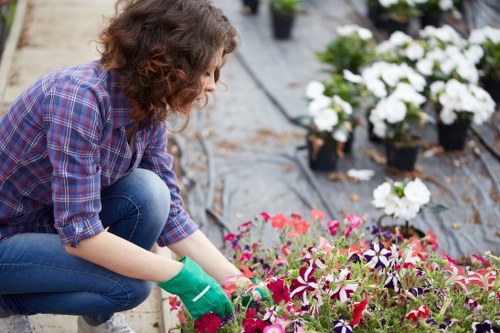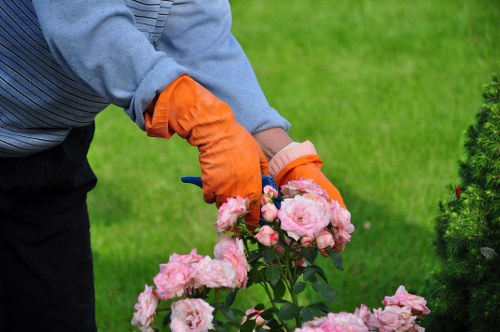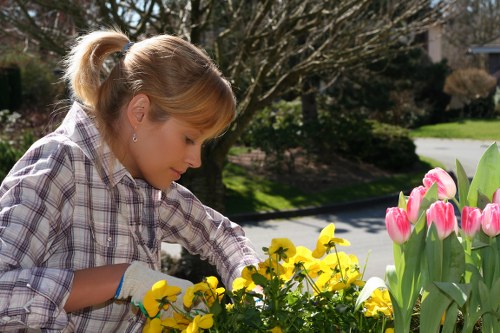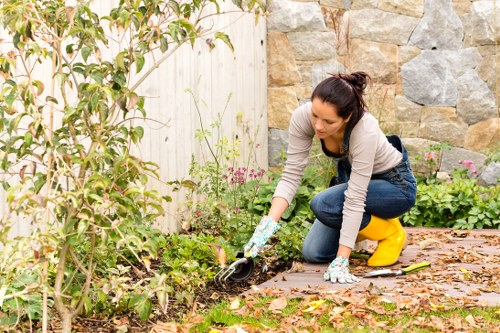Garden Maintenance in Thamesmead

Maintaining a beautiful garden in Thamesmead requires dedication, knowledge, and the right set of tools. Whether you're a seasoned gardener or a beginner, understanding the essential aspects of garden maintenance can transform your outdoor space into a vibrant and thriving haven.
Thamesmead, with its unique climate and soil conditions, presents both challenges and opportunities for garden enthusiasts. Proper maintenance ensures that your plants remain healthy, your garden stays aesthetically pleasing, and the overall ecosystem thrives.
In this guide, we'll explore the key areas of garden maintenance in Thamesmead, offering practical tips and insights to help you achieve and maintain a stunning garden all year round.

Seasonal Garden Maintenance
One of the most effective ways to ensure your garden remains in top condition is by adhering to a seasonal maintenance schedule. Each season brings its own set of tasks that are crucial for the health and appearance of your garden.
Spring Maintenance
Spring is the perfect time to rejuvenate your garden after the winter months. Start by clearing away any debris, pruning dead branches, and preparing the soil for new plantings.
- Soil Preparation: Test the soil pH and add necessary amendments to ensure optimal growing conditions.
- Planting: Introduce new plants and perennials that thrive in Thamesmead's climate.
- Mulching: Apply a layer of mulch to retain moisture and suppress weeds.
Summer Maintenance
Summer brings the heat, and maintaining adequate moisture levels is essential. Regular watering, especially during dry spells, ensures that your plants stay vibrant and healthy.
- Watering: Implement an efficient irrigation system to conserve water and ensure even distribution.
- Weed Control: Remove weeds promptly to prevent them from competing with your plants for nutrients.
- Pest Management: Monitor for pests and address any infestations early to prevent widespread damage.
Autumn Maintenance
As the weather cools, it's time to prepare your garden for the winter months. Clearing fallen leaves, protecting tender plants, and dividing perennials are key tasks.
- Leaf Removal: Regularly rake and remove fallen leaves to prevent fungal diseases.
- Plant Protection: Use frost covers or mulch to shield plants from cold temperatures.
- Pruning: Trim back overgrown shrubs and trees to encourage healthy growth in the spring.
Winter Maintenance
While many plants go dormant in winter, there are still tasks to keep your garden in good shape. Focus on maintaining garden structures and planning for the upcoming year.
- Tool Maintenance: Clean and store your gardening tools properly to extend their lifespan.
- Planning: Design your garden layout for the next season, considering new plant varieties and layout changes.
- Protection: Inspect and repair fences, decks, and other garden structures to withstand winter conditions.

Essential Garden Tools and Equipment
Having the right tools is fundamental to effective garden maintenance. Investing in quality equipment can make gardening tasks easier and more efficient.
Basic Tools
Every gardener should have a set of basic tools to handle routine tasks. These include:
- Hand Trowel: Ideal for digging small holes and transplanting seedlings.
- Pruning Shears: Essential for trimming and shaping plants.
- Garden Fork: Useful for turning soil and aerating garden beds.
- Watering Can or Hose: Ensures your plants receive adequate moisture.
Advanced Equipment
For more extensive garden maintenance, additional equipment can enhance your efficiency:
- Lawn Mower: Keeps your lawn neat and healthy.
- Leaf Blower: Quickly clears leaves and debris from hard-to-reach areas.
- Wheelbarrow: Facilitates the transportation of soil, plants, and tools.
- Electric or Gas-Powered Tools: Such as hedge trimmers and chainsaws, for larger maintenance tasks.
Tool Maintenance
Proper maintenance of your garden tools ensures their longevity and effectiveness. Regular cleaning, sharpening, and storage are essential practices.
- Cleaning: Remove dirt and debris after each use to prevent rust and corrosion.
- Sharpening: Keep blades sharp for precise cuts and efficient performance.
- Storage: Store tools in a dry, secure place to protect them from the elements.

Plant Care and Selection
Selecting the right plants for your Thamesmead garden is crucial for its success. Consider factors like climate, soil type, and maintenance requirements when choosing plants.
Choosing Native Plants
Native plants are well-suited to the local environment and often require less maintenance. They provide habitat for local wildlife and contribute to the biodiversity of your garden.
- Advantages: They are adapted to the climate, disease-resistant, and require minimal watering.
- Examples: Bluebells, foxgloves, and hawthorn.
Perennial vs. Annual Plants
Understanding the difference between perennials and annuals can help you plan a garden that blooms year after year.
- Perennials: These plants live for multiple years, providing long-term structure and color. They often require less replanting.
- Annuals: These complete their life cycle in one season, offering vibrant, seasonal color but needing annual replacement.
Plant Care Tips
Proper care extends the lifespan and beauty of your plants. Key aspects include watering, fertilizing, and pruning.
- Watering: Ensure consistent moisture levels, avoiding both overwatering and drought stress.
- Fertilizing: Provide essential nutrients to support healthy growth and blooming.
- Pruning: Regularly trim plants to maintain their shape and remove dead or diseased parts.

Lawn Care in Thamesmead
A well-maintained lawn is the cornerstone of any beautiful garden. It provides a lush green backdrop for your plants and a comfortable space for outdoor activities.
Mowing Techniques
Proper mowing practices promote a healthy lawn. Here are some tips:
- Mowing Height: Keep the grass at an optimal height to encourage thick growth and shade out weeds.
- Frequency: Mow regularly, approximately once a week during the growing season.
- Sharp Blades: Ensure mower blades are sharp for clean cuts, reducing stress on the grass.
Fertilization and Weed Control
Feeding your lawn with the right fertilizers supports robust growth, while effective weed control prevents unwanted plants from taking over.
- Fertilization: Apply a balanced fertilizer in spring and autumn to provide essential nutrients.
- Weed Control: Use pre-emergent and post-emergent herbicides to manage and prevent weed growth.
Aeration and Overseeding
Aerating your lawn helps alleviate soil compaction, allowing roots to grow deeper and access more nutrients.
- Aeration: Perform aeration in the growing seasons to improve soil structure.
- Overseeding: Introduce new grass seeds to fill in bare spots and enhance the lawn's density.
Irrigation Practices
Proper watering is vital for a healthy lawn. Implementing efficient irrigation practices conserves water and ensures even distribution.
- Time of Day: Water early in the morning to reduce evaporation and fungal growth.
- Deep Watering: Encourage deep root growth by watering thoroughly but less frequently.

Hardscaping and Garden Structures
Incorporating hardscaping elements adds functionality and aesthetic appeal to your garden. Structures like patios, fences, and pathways enhance the overall design and usability of your outdoor space.
Patios and Decks
Patios and decks provide a designated area for relaxation and entertainment. They can be constructed using various materials, including stone, wood, and composite decking.
- Design: Choose a design that complements your garden's layout and your personal style.
- Maintenance: Regular cleaning and sealing help preserve the appearance and integrity of patios and decks.
Fencing and Wall Structures
Fences and walls serve multiple purposes, from defining garden boundaries to providing privacy and security.
- Materials: Common materials include wood, metal, and brick, each offering different aesthetic and functional benefits.
- Installation: Ensure proper installation to withstand weather conditions and provide long-lasting support.
Pathways and Walkways
Pathways guide visitors through your garden and can highlight key areas and features. They also help prevent soil compaction in high-traffic zones.
- Materials: Options include gravel, paving stones, and concrete, each providing a unique look and feel.
- Design: Create winding paths for a natural appearance or straight lines for a more structured look.
Garden Lighting
Proper lighting enhances the beauty and safety of your garden, extending its usability into the evening hours.
- Types: Use a combination of ambient, task, and accent lighting to illuminate different areas.
- Energy Efficiency: Opt for LED lights to reduce energy consumption and maintenance costs.

Organic and Sustainable Gardening Practices
Adopting organic and sustainable practices in your garden not only benefits the environment but also promotes healthier plants and soil.
Composting
Composting recycles garden waste into nutrient-rich soil amendments, reducing the need for chemical fertilizers.
- Setup: Create a compost pile or use a compost bin to manage organic materials.
- Materials: Include a mix of green (vegetable scraps, grass clippings) and brown (leaves, straw) materials.
Natural Pest Control
Using natural methods for pest control minimizes harm to beneficial insects and the broader ecosystem.
- Beneficial Insects: Encourage predators like ladybugs and praying mantises to manage pest populations.
- Natural Repellents: Use neem oil, garlic spray, or other organic solutions to deter pests.
Rainwater Harvesting
Collecting and utilizing rainwater conserves water resources and provides your garden with a natural water supply.
- Rain Barrels: Install rain barrels to capture runoff from your roof.
- Usage: Use harvested rainwater for irrigation, reducing reliance on municipal water sources.
Mulching
Mulching helps retain soil moisture, suppress weeds, and regulate soil temperature, contributing to a healthier garden.
- Types: Organic mulches like bark, straw, and compost, or inorganic options like gravel and rubber.
- Application: Apply a 2-3 inch layer around plants and garden beds.

Professional Garden Maintenance Services
While DIY gardening can be rewarding, professional garden maintenance services in Thamesmead offer expertise and efficiency, ensuring your garden remains immaculate.
Lawn Care Services
Professional lawn care includes mowing, fertilizing, aeration, and pest control, tailored to your lawn's specific needs.
- Customized Plans: Services are designed based on the type of grass, soil conditions, and desired outcomes.
- Expertise: Trained professionals use advanced equipment for superior results.
Planting and Landscaping
Experts assist in selecting the right plants, designing garden layouts, and implementing landscaping features that enhance your garden's beauty and functionality.
- Design Services: Create aesthetically pleasing and sustainable garden designs.
- Implementation: Professional planting ensures proper spacing, depth, and care for new plants.
Pruning and Trimming
Regular pruning promotes healthy plant growth, improves appearance, and maintains safety around structures.
- Scheduled Pruning: Timely pruning based on plant species and growth cycles.
- Safety: Professionals handle high or difficult-to-reach branches safely.
Garden Clean-Up
Seasonal clean-ups involve removing debris, fallen leaves, and dead plants, preparing your garden for the next season.
- Efficiency: Teams work quickly to restore your garden's appearance.
- Comprehensive Services: Includes clearing, composting, and waste disposal.
Irrigation System Installation and Maintenance
Proper irrigation is key to a thriving garden. Professionals install and maintain efficient watering systems tailored to your garden's needs.
- System Design: Customized layouts ensure even water distribution.
- Maintenance: Regular checks prevent leaks and ensure optimal performance.

Common Garden Challenges in Thamesmead
Gardening in Thamesmead comes with its own set of challenges, from variable weather conditions to specific soil types. Understanding these challenges can help you address them effectively.
Soil Quality
Thamesmead's soil can vary, often requiring amendments to support healthy plant growth.
- Testing: Conduct soil tests to determine pH levels and nutrient content.
- Amendments: Add compost, lime, or sulfur to adjust pH and improve fertility.
Weather Extremes
Managing the effects of extreme weather, such as heavy rains or droughts, is crucial for garden health.
- Drainage: Ensure proper drainage to prevent waterlogging during heavy rains.
- Irrigation: Implement efficient watering systems to combat drought conditions.
Pests and Diseases
Protecting your garden from pests and diseases involves regular monitoring and proactive management.
- Integrated Pest Management: Combine biological, cultural, and chemical methods for effective control.
- Disease Prevention: Maintain plant health through proper watering, spacing, and sanitation.
Invasive Species
Invasive plants can outcompete native species, disrupting the garden's ecosystem.
- Identification: Learn to recognize and remove invasive species promptly.
- Prevention: Prevent introduction by monitoring plant introductions and maintaining healthy plant populations.
Urban Wildlife
While wildlife adds life to your garden, certain animals can cause damage to plants and structures.
- Protection: Use fencing, repellents, or natural barriers to deter unwanted wildlife.
- Habitat Creation: Encourage beneficial wildlife while managing potential nuisances.

Enhancing Your Garden's Aesthetics
Creating a visually appealing garden involves thoughtful design, plant selection, and the incorporation of various elements that complement each other.
Color Coordination
Choosing plants with complementary colors can create a harmonious and vibrant garden palette.
- Color Schemes: Use analogous or complementary color schemes for visual interest.
- Seasonal Blooms: Select plants that bloom at different times to ensure year-round color.
Texture and Structure
Incorporating a variety of plant textures and structural elements adds depth and dimension to your garden.
- Plant Varieties: Mix plants with different leaf shapes, sizes, and foliage textures.
- Hardscaping: Use pathways, stones, and garden structures to introduce structural variety.
Water Features
Water features like fountains, ponds, or waterfalls can add tranquility and a focal point to your garden.
- Design: Choose a water feature that fits the scale of your garden and complements the overall design.
- Maintenance: Regular cleaning and upkeep are necessary to keep water features functioning and attractive.
Garden Art and Decor
Incorporating art and decorative elements personalizes your garden and enhances its aesthetic appeal.
- Sculptures: Add sculptures or statues for artistic expression.
- Decorative Planters: Use unique planters to showcase plants and complement the garden's theme.
Lighting and Ambiance
Proper lighting not only highlights key features but also creates a welcoming atmosphere in the evening.
- Path Lighting: Illuminate walkways for safety and accessibility.
- Accent Lighting: Highlight garden art, water features, and unique plants.

Eco-Friendly Gardening Practices
Adopting eco-friendly practices in your garden contributes to environmental sustainability and promotes a healthy ecosystem.
Composting and Recycling
Recycling garden waste through composting reduces landfill contributions and enriches the soil.
- Benefits: Produces nutrient-rich compost, reduces waste, and enhances soil structure.
- Methods: Set up compost bins or piles and manage them with a balanced mix of green and brown materials.
Water Conservation
Implementing water-saving techniques ensures that your garden remains lush while conserving this vital resource.
- Drip Irrigation: Delivers water directly to plant roots, minimizing evaporation.
- Rainwater Harvesting: Collects and stores rainwater for garden use.
Organic Gardening
Choosing organic methods over chemical alternatives supports a healthier environment and reduces pollution.
- Naturally Derived Pest Control: Use organic pesticides and encourage beneficial insects.
- Natural Fertilizers: Opt for compost, manure, and other organic fertilizers instead of synthetic options.
Native and Drought-Resistant Plants
Selecting native and drought-resistant plants reduces water usage and supports local biodiversity.
- Adaptation: These plants are naturally suited to Thamesmead's climate and soil conditions.
- Maintenance: Require less watering and care, making them ideal for sustainable gardening.
Reducing Chemical Usage
Minimizing the use of chemicals in your garden promotes a healthier environment and prevents soil contamination.
- Alternative Solutions: Use manual weeding, organic fertilizers, and natural pest repellents.
- Safety: Reduces the risk of harm to beneficial insects, wildlife, and humans.

Creating a Sustainable Garden Ecosystem
A sustainable garden ecosystem fosters a balanced environment where plants, insects, and animals coexist harmoniously. Implementing the following strategies can help establish such an ecosystem in your Thamesmead garden.
Attracting Beneficial Wildlife
Encouraging beneficial wildlife enhances garden health by promoting pollination and natural pest control.
- Pollinators: Plant flowers that attract bees, butterflies, and other pollinators.
- Birds: Install birdhouses and bird feeders to attract birds that feed on insects.
Creating Habitat Diversity
Diverse habitats support a variety of species, contributing to a robust and resilient garden ecosystem.
- Plant Variety: Incorporate a mix of trees, shrubs, perennials, and annuals.
- Water Sources: Include ponds or birdbaths to provide water for wildlife.
Soil Health Management
Healthy soil is the foundation of a thriving garden. Practices that improve soil health are essential for sustainability.
- Cover Crops: Grow cover crops to prevent erosion and enrich the soil.
- Organic Matter: Regularly add compost and organic matter to enhance soil fertility and structure.
Integrated Pest Management (IPM)
IPM balances pest control with environmental preservation, using a combination of techniques to manage pests effectively.
- Monitoring: Regularly inspect plants for signs of pests or diseases.
- Control Methods: Use biological controls, such as introducing predator insects, and mechanical methods like traps.
Energy-Efficient Garden Practices
Implementing energy-efficient practices reduces your garden's carbon footprint and promotes sustainability.
- Solar Lighting: Use solar-powered lights to illuminate your garden without relying on electricity.
- Manual Tools: Opt for manual gardening tools over gas-powered ones to decrease emissions.
Composting and Waste Reduction
Effective composting and waste reduction minimize your garden's impact on the environment.
- Composting: Turn organic waste into valuable compost to nourish your garden soil.
- Recycling: Reuse materials like mulch and reclaimed wood for garden projects.

Community and Educational Resources
Engaging with community and educational resources can enhance your gardening knowledge and connect you with like-minded individuals in Thamesmead.
Local Gardening Groups
Joining local gardening clubs or groups provides opportunities for learning, sharing experiences, and gaining support.
- Meetups: Participate in regular meetings and events hosted by local gardening enthusiasts.
- Workshops: Attend workshops and seminars to learn new gardening techniques and trends.
Educational Workshops and Seminars
Educational programs offer in-depth knowledge on various gardening topics, from organic farming to landscape design.
- Topics: Topics may include soil health, plant propagation, and sustainable gardening practices.
- Expert Instructors: Learn from experienced gardeners and horticulturists.
Local Nurseries and Garden Centers
Visiting local nurseries and garden centers provides access to a wide range of plants, tools, and expert advice tailored to Thamesmead's environment.
- Plant Selection: Choose plants that are well-suited to the local climate and soil conditions.
- Professional Advice: Seek guidance on plant care, pest management, and garden design.
Online Gardening Communities
Engaging with online forums and social media groups connects you with a broader gardening community, offering tips, inspiration, and support.
- Forums: Participate in discussions and seek advice on specific gardening challenges.
- Social Media: Follow gardening pages and join groups to stay updated on the latest trends and techniques.
Local Garden Tours and Events
Attending garden tours and events showcases innovative garden designs and provides inspiration for your own garden.
- Inspiration: Discover new plant varieties, design ideas, and sustainable practices.
- Networking: Connect with other gardeners and professionals in the field.
Library and Online Resources
Accessing books, magazines, and online resources expands your gardening knowledge and keeps you informed about best practices.
- Books: Read comprehensive guides and specialized texts on various gardening topics.
- Online Articles: Stay updated with the latest trends, tips, and research in gardening.

Final Thoughts on Garden Maintenance in Thamesmead
Maintaining a garden in Thamesmead is a rewarding endeavor that combines creativity, patience, and care. By following the best practices outlined in this guide, you can ensure that your garden remains a beautiful and sustainable space for years to come.
Whether you choose to undertake garden maintenance yourself or enlist the help of professional services, the key is consistency and attention to detail. Regular upkeep not only enhances the aesthetic appeal of your garden but also contributes to a healthier environment and a more enjoyable outdoor living experience.
For those seeking expert assistance, contact us today to discover how our garden maintenance services in Thamesmead can transform your outdoor space into a thriving paradise. Book your service now and take the first step towards achieving the garden of your dreams.

